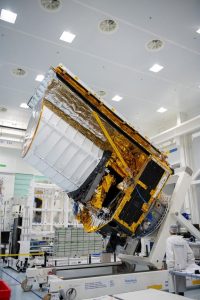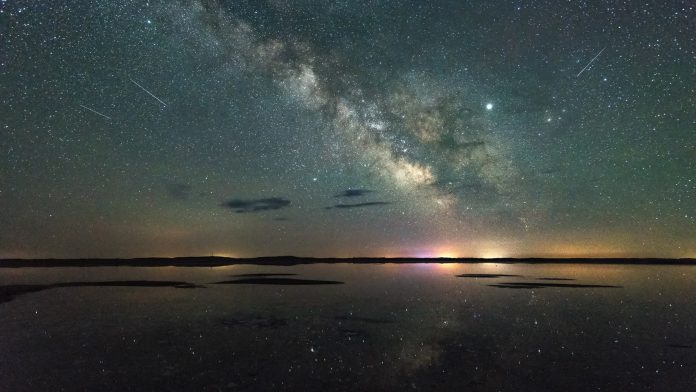Using cosmological surveys to trace the evolution of the Universe and understand its accelerated expansion.
In the last hundred years, cosmology has made significant steps to understand the composition, structure and evolution of the Universe: We have discovered that the Universe is expanding; that it started from a dense and hot state known as the Big Bang; and that it is made of very little ordinary matter and more abundant mysterious components like dark matter and dark energy. The latter is responsible for the accelerated expansion of the Universe. In recent years, many projects are being developed to better understand these components and find an explanation for the acceleration of the Universe. Our group at the Institute of Space Sciences of the Spanish National Research Council (ICE-CSIC) and the Institut d’Estudis Espacials de Catalunya (IEEC) is actively involved in several of the most ambitious cosmological surveys to explore the Universe.
Mapping the Universe
Galaxies are massive and luminous objects that are distributed throughout the Universe and serve as tracers of space and time. The positions of galaxies map the spatial structure of the cosmos. Moreover, as we observe galaxies as they were in the past, given the finite speed of light, galaxies also trace the evolution of the Universe. The distance between galaxies and the volume of the Universe are both enormous. Therefore, we need very large surveys to sample enough volume and time evolution to be able to characterise the Universe. In these surveys, we need to locate the positions of the galaxy tracers to study their distribution. Imaging surveys can determine the angular position of galaxies precisely and spectroscopy is needed to measure their radial distances accurately. Spectroscopic surveys are more costly than imaging surveys, as you need to disperse the light to measure the galaxy redshifts that determine their distances. Ideally, we would have both types of survey to gather as much information as possible about the position and properties of the galaxies under study.
The PAU Camera and Survey: determining distances with images
Imaging surveys can also determine the galaxy redshifts if observations are taken in several bands. We can push this method of determining photometric redshifts, increasing the sampling of the galaxy spectral energy distributions (SEDs), observing with many filters. Our group, in collaboration with other groups at the Institut de Física d’Altes Energies (IFAE), the Centro de Investigaciones Energéticas, Medioambientales y Tecnológicas (CIEMAT), and the Instituto de Física Teórica (IFT) designed and built the Physics of the Accelerating Universe (PAU) Camera. The camera is equipped with 40 narrow band filters and six broad band filters that allow us to finely sample the galaxies SEDs and thus obtain precise and accurate photometric redshifts. It is mounted at the prime focus of the William Herschel Telescope of the Roque de los Muchachos Observatory in the Canary Islands (see Fig. 1). PAUCam is a light-weight camera made mostly of carbon-fibre to reduce the weight load on the prime focus of the telescope. We have been using the camera to conduct the PAU Survey, imaging four fields where there is already deep imaging with PAUCam’s 40 narrow band filters. The performance of the camera is within specifications, delivering photometric redshifts around ten times more precise than those obtained with traditional broad band filters. We are now starting the scientific exploitation of the data enabled by the better sampling of the galaxies SEDs and the unbiased nature of the observation. In addition, we are using our data to help calibrate other larger surveys like the Dark Energy Survey (DES) and the Euclid mission.

Gravitational lensing
In addition to the position of the galaxies, the galaxy shapes also carry cosmological information. The light of background galaxies is deflected by the mass between these source galaxies and us. We refer to this phenomenon as gravitational lensing. It changes the shapes, sizes and observed fluxes of the background objects. By measuring these distortions, we can potentially measure the mass distribution in the universe, making gravitational lensing a very powerful tool to study the Universe. However, the shear induced in the galaxy shapes is much smaller than the intrinsic ellipticities that galaxies inherently have, and statistics of several galaxies are needed to disentangle the tiny cosmological induced shear from the intrinsic shape.
The Euclid mission, cosmology from space
Measuring gravitational weak lensing effects from the ground is difficult as the atmosphere blurs the galaxy images hindering the measurement of the small gravitational lensing distortions. To overcome this difficulty and exploit the great promise of gravitational lensing, observations need to be taken from space. The European Space Agency has responded to this challenge approving the Euclid mission. Euclid is a cosmology mission designed to understand why the expansion of the Universe is accelerating and what is the nature of the source responsible for this acceleration that physicists refer to as dark energy.
Euclid consists of a 1.2m telescope with two instruments: a visible imager (VIS) to take wide field sharp images and a near-infrared spectrophotometer (NISP) that can image and take slitless spectroscopy in the near-infrared (see Fig. 2). Euclid will explore how the Universe evolved over the past 10 billion years to address questions related to fundamental physics and cosmology on the nature and properties of dark energy, dark matter and gravity, as well as on the physics of the early Universe and the initial conditions which seeded the formation of cosmic structure. The imprints of dark energy and gravity will be tracked by using two complementary cosmological probes to capture signatures of the expansion rate of the Universe and the growth of cosmic structures: weak gravitational lensing, measuring the distortion of galaxy shapes, and galaxy clustering, determining the positions of galaxies and their distribution.
Euclid is expected to be launched in 2022 and will complete a cosmological survey in six years, covering 15000 square degrees on the sky. The complete survey will collect hundreds of thousands of images and several tens of Petabytes of data. About 10 billion sources will be observed by Euclid, out of which more than one billion will be used for weak lensing studies and several tens of million galaxy redshifts will be also measured and used for galaxy clustering. The scientific analysis and interpretation of these data is led by the scientists of the Euclid Consortium.

Our group is deeply involved in Euclid. Together with IFAE, we were responsible for providing the filter wheel assembly (FWA) for the NISP instrument of the telescope. We delivered the Flight Model of the FWA for integration in the NISP in December 2019. Along with the Port d’Informació Científica (PIC), we provide high-resolution simulations of the structure of the Universe for later comparison with the observations and data to be obtained with the satellite. We are responsible for the Simulations Organisation Unit of the Euclid Science Ground Segment. PIC hosts the Euclid Spanish Science Data Center. In 2018, together with the University of Zurich, we released to the collaboration the Flagship Simulation, that served as input for the Science Performance Verification 2 of the mission and the Mission Critical Design Review (CDR). The Flagship Simulation was the largest N-body simulation run at that time.
Euclid represents the next step of cosmological surveys, where data are taken from space to avoid the disturbance of the Earth atmosphere. It comprehensively combines the information from weak lensing and galaxy clustering to determine the structure of the Universe. Our group at ICE-CSIC and IEEC is well placed to exploit and interpret the data that Euclid will gather.
Acknowledgement
Francisco J Castander acknowledges support from the Ministerio de Ciencia e Innovacion project PID2019-111317GB-C31.








